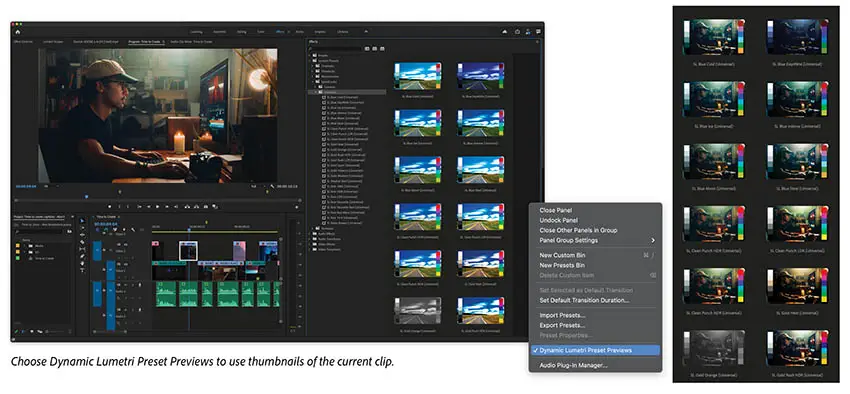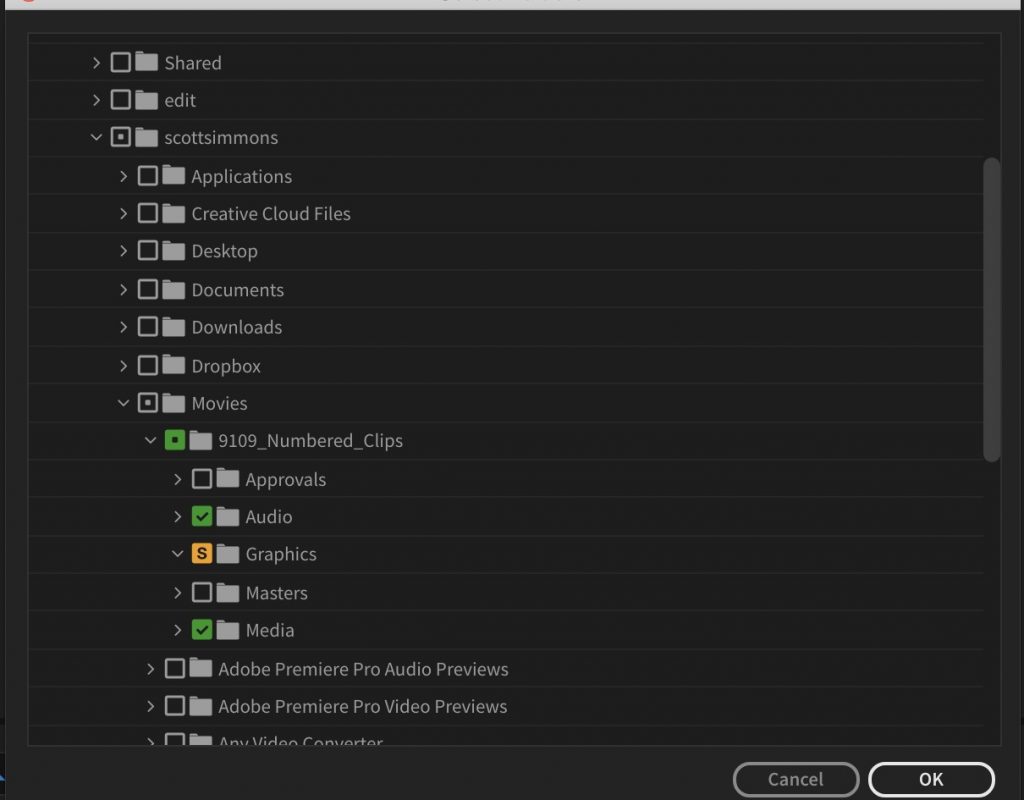Cover image via
The latest news and updates from 2020’s Adobe Max conference, including quick export for Premiere Pro and Roto Brush 2 for After Effects.
2020 might have taken away in-person film festivals and conferences, but that doesn’t mean innovation and updates are on hold in the film and video industry. Adobe Max 2020 (which is both digital and free this year, from Oct. 20-22nd) is in full swing and the brand has plenty of major updates to its legacy applications like Photoshop, Premiere Pro, After Effects and its growing Creative Cloud.
How to Import After Effects Comps to Premiere After creating a comp in After Effects (and saving the project), open Premiere Pro and head to the project panel. Right click and select Import. Then simply find the After Effects project with your desired comp, select it, and click open. Select the part of the sequence you want to be exported into After Effects, then right click. Click Replace With After Effects Composition, which is near the top of the menu. From there, it'll open the sequence as an After Effects project, although some elements may have changed (and it will say so) because they are different software. How to Import After Effects Comps to Premiere After creating a comp in After Effects (and saving the project), open Premiere Pro and head to the project panel. Right click and select Import. Then simply find the After Effects project with your desired comp, select it, and click open.
Let’s take a look at some of the updates, news, and highlights of interest to film and video professionals as Premiere Pro gets faster, After Effects gets smarter, and the Cloud gets bigger and better than ever.
Adobe Premiere Pro After Effects Download
Updates to Adobe Premiere Pro
Adobe has announced their latest update to Premiere Pro with version 14.5. It’s set to further speed up their NLE platform with added support for AMD and Intel GPUs to go along with their already updated ProRes RAW support from earlier this year. This new hardware decoding update will allow for H.264/H.265 formats with the above GPUs on Windows to help speed up Premiere Pro across the board. Here are the rest of the major updates:
- Updated audio pre-roll for faster and more responsive playback for larger projects.
- Support for HDR workflows that use Rec.2100 PQ color working space for both Premiere Pro and After Effects.
- ARRI ProRes now allows color management and the ability to work with embedded LUTs (including switching between Rec.709 LUTs and HLG LUTs).
- Added support for ProRes RAW to LOG color space conversion across the cloud.

Adobe has also unveiled new technology for a “quick export” feature that will allow for users to quickly (obviously) and easily export their most frequently used settings directly from the platform’s header bar, without going through the multiple steps currently involved. You’ll also be able to customize settings and quickly match source settings or go with a default high-quality H264. The quick export is available as part of the new Premiere Pro Beta.

Updates to Adobe After Effects
Adobe After Effects is also getting a boost with updates that include a new mode for working smarter — and more skillfully — with 3D tools. As you can see in the video demonstration above, these new 3D tools are all about “quality of life” for those interested in working specifically with complex 3D layers and will improve how these layers can be transformed and changed at the most basic and core levels. Here are the big new features:
- 3D Transform Gizmos
- Improved Camera Tools
- Real-time 3D Draft Preview
- New 3D Ground Plane
Along with the new updates for 3D tools, Adobe has also unveiled a new Roto Brush 2 for After Effects. This new technology, which is powered by Adobe Sensei, presents an even greater way for users to separate foreground objects from their backgrounds with more precisio. Roto Brush 2 is a major update from the previous iteration and also allows for frame-by-frame object tracking and much smarter propagate selection over time. All said, this should speed up many creative tasks to help create some very cool effects.
Similar to some of the updates for Premiere Pro, you can access all these new features in the new Adobe Beta before they all eventually make their way into the next updates.
Updates to the Creative Cloud
Plugins are getting a major overhaul for the next generation of the Creative Cloud.
As always with a major conference like Adobe Max, the brand has plenty of updates across the huge array of apps and platforms available as part of their Creative Cloud. From updates for improving Photoshop and image manipulation, to new collaboration elements and curated collections, there’s a lot to check out. Here are some of the biggest highlights for those that cross-over with video production.
- Live Streaming: you can now livestream your work from Photoshop, Illustrator, and Fresco.
- Photoshop Discover panel: new troubleshooting help for Photoshop using Adobe Sensei’s AI to better help those stuck.
- Accelerate collaboration: new collaboration tools across the cloud for those working remote or stuck at home.
- Cloud Documents: quick sharing between Photoshop, Illustrator and Fresco with new cloud documents.
- Neural filters in Photoshop: change expressions, skin tones and clean up images in a few clicks with new Neural Filters in Photoshop.
- Innovation in 3D & immersive creation: augment reality experiences continue to improve and expand in the cloud with Adobe Aero for more powerful 3D effects.
- New ways to access and use plugins: Adobe’s plugin system is getting a major upgrade with how you can find, install and keep up with all available plugins for every platform.
Overall, these new overhauls to the Creative Cloud, along with the major updates to Premiere Pro and After Effects should be great news for all those who are already on the platform, as well as those who are interested in checking it out.
For more Premiere Pro news and tons of great assets and freebies, check out these articles below.
Cover image via
After Effects and Premiere Pro are two of Adobe’s flagship post-production apps. But which one do you need for which task? Let’s find out.
When you’re creating a new project, knowing when to use Premiere and when to use After Effects can make or break your project. They are both extremely powerful programs, that can sometimes perform the same functions, but most of the time, one of them is better at something than the other.
Now the differences between these two programs are pretty apparent to anyone who has used them before. But, if you’re new to the suite, it can be confusing determining which one you need to learn for a given post-production task.
Let’s take a look at Adobe’s two main video production software tools and see what they do — and when to use one over the other.
Adobe Premiere Pro
Adobe Premiere Pro is an NLE (nonlinear editor) with the main function of editing video clips together in a sequence. This is the program that most beginners open to create a simple video with multiple clips and music. It’s incredibly scalable — easy to use for beginners, and still powerful enough for a master editor. It’s got just about everything you need to complete a professional video: a clip editor, color correction tools, audio programs, and even graphics software.
Tasks for Premiere:
- Editing a video with existing clips imported from a camera.
- Editing audio within your video — Premiere’s audio functions far surpass AE’s.
- Placing transitions between clips within your timeline.
- Creating/polishing any type of video — short films, music videos, social videos, etc.
Adobe Premiere Effects Free
Adobe After Effects
Adobe After Effects is a digital motion graphics platform used to create either simple animations or intricate graphics sequences. If you ever hear of a “motion graphics expert,” chances are they’re proficient in After Effects. The program adds motion to layers and assets that you couldn’t do in Premiere. Its motion tools are much better than Premiere’s, and it’s the preferred tool for adding motion to videos, images, and designs. It’s a “hard to learn, easy to master” type of program, but once you get the hang of it, it’s essential for creating motion graphics or visual effects for your projects.
Tasks for After Effects:

- Creating motion graphics packages for your projects.
- Adding motion blur and movement to assets and layers.
- Manipulating multilayer sequences that require detailed keyframing.
- Creating title sequences that include keyframe-based animations.
After Effects Vs. Premiere Pro: What’s the Difference?
To sum it all up, Premiere assembles all of your assets and creates a final video product, while After Effects is mainly an asset-generation tool. People complete projects in After Effects all the time, though — it’s great for creating motion-based social video with only a song bed underneath, or even creating a full animation.
So really, there’s no true “vs.” in this argument. It’s kind of like debating PowerPoint and Word — you use them for different tasks, even though they share some similar functions. They are extremely well linked, though — and like many editors, I use them concurrently all of the time. Once you get familiar with both programs, you’ll learn how to dynamically link After Effects compositions to your Premiere projects so you can access both assets at the same time. (For more information about dynamic linking, check out the video by Justin Odisho above.)
Adobe Premiere Pro Free Download
Looking for more on Premiere and After Effects? Check these out.
